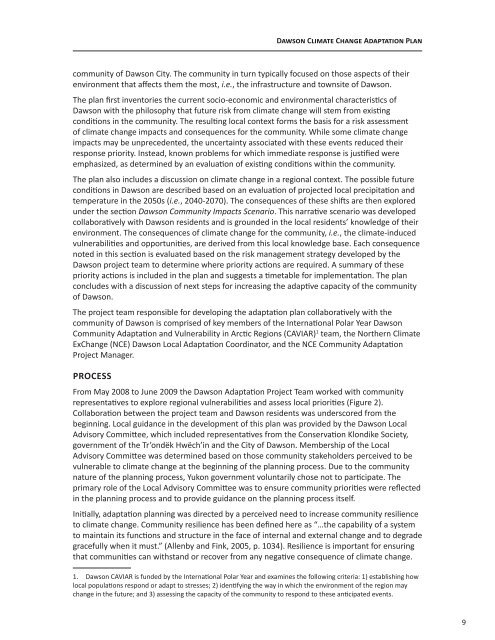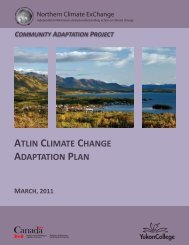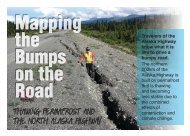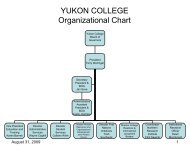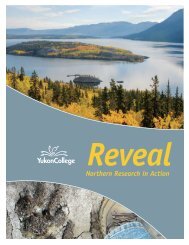Dawson Climate Change Adaptation Plan, Revised ... - Yukon College
Dawson Climate Change Adaptation Plan, Revised ... - Yukon College
Dawson Climate Change Adaptation Plan, Revised ... - Yukon College
You also want an ePaper? Increase the reach of your titles
YUMPU automatically turns print PDFs into web optimized ePapers that Google loves.
<strong>Dawson</strong> <strong>Climate</strong> <strong>Change</strong> <strong>Adaptation</strong> <strong>Plan</strong>community of <strong>Dawson</strong> City. The community in turn typically focused on those aspects of theirenvironment that affects them the most, i.e., the infrastructure and townsite of <strong>Dawson</strong>.The plan first inventories the current socio-economic and environmental characteristics of<strong>Dawson</strong> with the philosophy that future risk from climate change will stem from existingconditions in the community. The resulting local context forms the basis for a risk assessmentof climate change impacts and consequences for the community. While some climate changeimpacts may be unprecedented, the uncertainty associated with these events reduced theirresponse priority. Instead, known problems for which immediate response is justified wereemphasized, as determined by an evaluation of existing conditions within the community.The plan also includes a discussion on climate change in a regional context. The possible futureconditions in <strong>Dawson</strong> are described based on an evaluation of projected local precipitation andtemperature in the 2050s (i.e., 2040-2070). The consequences of these shifts are then exploredunder the section <strong>Dawson</strong> Community Impacts Scenario. This narrative scenario was developedcollaboratively with <strong>Dawson</strong> residents and is grounded in the local residents’ knowledge of theirenvironment. The consequences of climate change for the community, i.e., the climate-inducedvulnerabilities and opportunities, are derived from this local knowledge base. Each consequencenoted in this section is evaluated based on the risk management strategy developed by the<strong>Dawson</strong> project team to determine where priority actions are required. A summary of thesepriority actions is included in the plan and suggests a timetable for implementation. The planconcludes with a discussion of next steps for increasing the adaptive capacity of the communityof <strong>Dawson</strong>.The project team responsible for developing the adaptation plan collaboratively with thecommunity of <strong>Dawson</strong> is comprised of key members of the International Polar Year <strong>Dawson</strong>Community <strong>Adaptation</strong> and Vulnerability in Arctic Regions (CAVIAR) 1 team, the Northern <strong>Climate</strong>Ex<strong>Change</strong> (NCE) <strong>Dawson</strong> Local <strong>Adaptation</strong> Coordinator, and the NCE Community <strong>Adaptation</strong>Project Manager.PROCESSFrom May 2008 to June 2009 the <strong>Dawson</strong> <strong>Adaptation</strong> Project Team worked with communityrepresentatives to explore regional vulnerabilities and assess local priorities (Figure 2).Collaboration between the project team and <strong>Dawson</strong> residents was underscored from thebeginning. Local guidance in the development of this plan was provided by the <strong>Dawson</strong> LocalAdvisory Committee, which included representatives from the Conservation Klondike Society,government of the Tr’ondëk Hwëch’in and the City of <strong>Dawson</strong>. Membership of the LocalAdvisory Committee was determined based on those community stakeholders perceived to bevulnerable to climate change at the beginning of the planning process. Due to the communitynature of the planning process, <strong>Yukon</strong> government voluntarily chose not to participate. Theprimary role of the Local Advisory Committee was to ensure community priorities were reflectedin the planning process and to provide guidance on the planning process itself.Initially, adaptation planning was directed by a perceived need to increase community resilienceto climate change. Community resilience has been defined here as “…the capability of a systemto maintain its functions and structure in the face of internal and external change and to degradegracefully when it must.” (Allenby and Fink, 2005, p. 1034). Resilience is important for ensuringthat communities can withstand or recover from any negative consequence of climate change.1. <strong>Dawson</strong> CAVIAR is funded by the International Polar Year and examines the following criteria: 1) establishing howlocal populations respond or adapt to stresses; 2) identifying the way in which the environment of the region maychange in the future; and 3) assessing the capacity of the community to respond to these anticipated events.9


